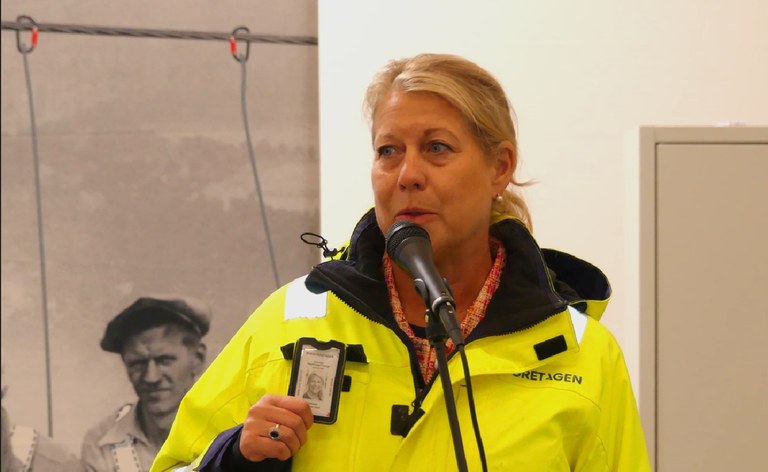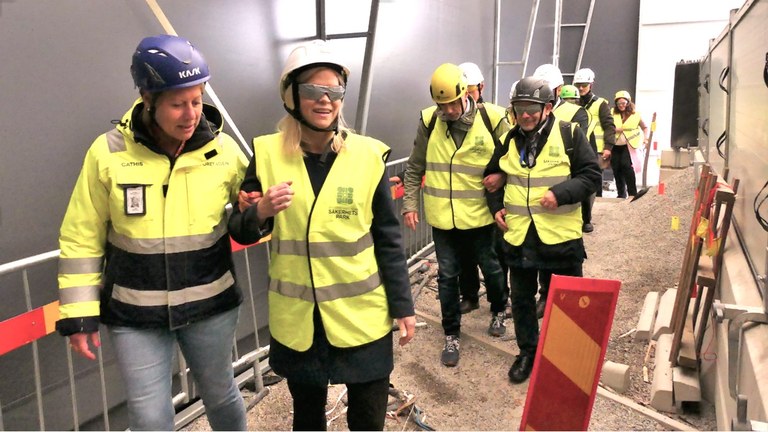All senses need to be tuned to safety
To reduce construction site risks, the Safety Park focuses on several senses. That is why you could witness dancing EU politicians and a Swedish labour minister trying out what it feels like being blind, as participants from the EU work environment conference came to visit.
“It is all about seeing, listening, doing and reflecting,” says Mattias Lafvas from the NCC construction company, who is doing a guided tour.
The Construction Industries Safety Park is situated a few kilometres from Stockholm Arlanda Airport and is run by an economic association founded in 2019 which comprises 56 member companies. 69 different providers of various safety systems are demonstrating their products. The concept originated in Finland, where there are three such safety parks.
The European study group is welcomed in a large construction tent in front of a small stage carrying a large black and white photograph of American construction workers taking a break, sitting on a steel girder during the construction of a skyscraper hundreds of metres above the ground. In this version of the famous photo, however, they have been equipped with modern safety lines.

Catharina Elmsäter-Svärd, CEO of the Swedish Construction Federation, shows the ID card that everyone working on a Swedish construction site must have – part of getting rid of cowboy operators. Over her shoulder, the image of American construction workers wearing safety lines.
An introductory video shows a construction worker who forgets to attach himself to such a line and falls from a much lesser, yet still deadly, height. What is captivating about this video is that one-third of it is about the construction worker’s family life before the accident, where he watches his daughter ride a bike for the first time and where they are throwing skipping stones on the beach together.
The sequence with the accident is brief, but the final third of the film shows the family doing the same activities, yet this time without a father.
“This video always makes me emotional,” says Mattias Lafvas.
“But this is what our work to try to prevent fatal accidents is all about. The reality is that there is one fatal accident every month in the Swedish construction industry. In the first three years since the Safety Park opened, 2,000 people from construction companies have taken a course and 2,000 have finished our training programmes.
“It is one thing being told something. If you see it with your own eyes you remember it better and if you get to do something yourself you remember it even better. But you also need to reflect in order to understand how to use what you have learned in everyday life and on the construction site,” says Mattias Lafvas.

Nicolas Schmit witnessing one of the situations demonstrating various accidents. In this case, a not altogether convincing doll.
This is what is best done in a group, and that is why the Safety Park will not be overtaken by computer technology simulating accidents – even if things might have looked more realistic in virtual reality than the fairly basic dolls that have been placed around the Safety Park where they become victims of accidents, like having a concrete wall fall on them.
“But it is not impossible that VR could be used for a few things here at the Safety Park too,” says Catharina Elmsäter-Svärd, CEO of the Swedish Construction Federation.
She helps out as the Swedish Deputy Minister of Employment Paulina Brandberg and other participants on the study trip get to experience how it feels to be blind and walk around a construction site, with bits of planks, plastic piping, shingle and ditches creating obstacles. When you cannot see, everything suddenly feels much more dangerous.

Catharina Elmsäter-Svärd leads Paulina Brandberg around a route which shows how a construction site might look. The government minister has been given glasses that have been taped shut, preventing her from seeing anything.
In one room the visitors get a demonstration of the link between weight and speed – a hammer dropped by someone from the tenth floor will hit a person on the ground with the same force as if you hold a 40-centimetre-long steel girder over your head and let go.
“All tools should be secured to your work clothes – one of these flexible tool lines only costs a few kronor,” says Mattias Falvas.
The most common cause of accidents in the construction industry is people losing control over hand-held tools like knives, saws, nail guns or drills.
“Out of all the hand-held tools, knives cause the most injuries. The most commonly reported knife injuries are caused by Stanley knives, Mora knives and retractable utility knives. The most common type of accident is when the knife slips and people cut their fingers or hands”, according to a brochure from the Swedish Construction Federation
- Gym session
-
The visit to the Construction Industries Safety Park began with a gym session. EU Commissioner Nicolas Schmit, Deputy Minister of Employment Paulina Brandberg and Stefan Zrinzo Azzopardi, Malta's Minister of Public Works and Planning, participated enthusiastically. On the podium, Mattias Lafvas.

 Follow us on Facebook
Follow us on Facebook
